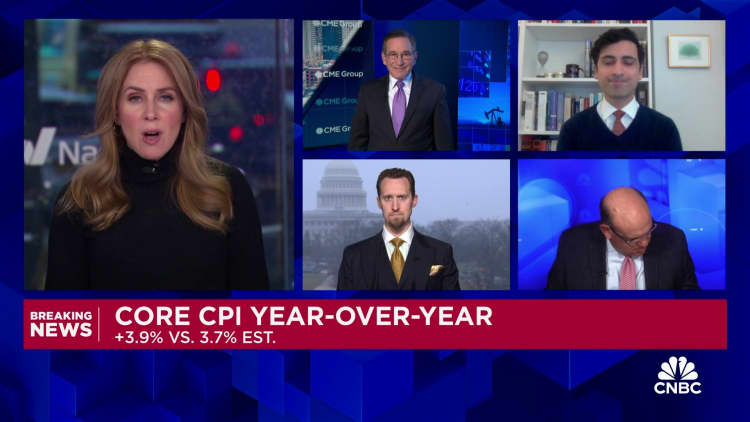People shop at a home improvement store in Brooklyn on Jan. 25, 2024.
Spencer Platt | Getty Images News | Getty Images
Inflation declined in January and consumers’ buying power rose as price pressures for U.S. goods and services continued to ease.
The consumer price index, a key inflation gauge, rose 3.1% in January relative to a year earlier, the U.S. Labor Department said Tuesday. That’s down from 3.4% in December.
The CPI measures how fast the prices of everything from fruits and vegetables to haircuts, concert tickets and household appliances are changing across the U.S. economy.
While that overall downward trend is encouraging, there were a few “disappointments” under the surface, as inflation rose from December to January in categories such as shelter, food, electricity and airline fares, said Mark Zandi, chief economist at Moody’s Analytics.
Ultimately, it’s likely just a “brief detour” from the broader disinflation trend, which is unlikely to move in a perfectly straight line, he added.
“You get zigs and zags in all these data, and this was just a zag,” Zandi said. “The bottom line: Inflation continues to moderate. It’s still uncomfortably high — though … moving in the right direction. And all the trend lines still look good aside from today’s data detour.”
Workers’ paychecks can buy more
Inflation has fallen significantly from its pandemic-era peak, 9.1%, in June 2022. Around that time, the average consumer’s paycheck wasn’t keeping up with fast-rising prices. Their so-called “real earnings” — earnings after accounting for inflation — were negative for more than two years.
That dynamic has reversed: Workers’ hourly pay has exceeded the rate of inflation since May. In other words, their wages can buy more. Real average hourly earnings rose by 1.4% between January 2023 and January 2024, the Labor Department said Tuesday.
Normalizing inflation means consumers don’t need to spend down their “excess savings” to support spending, according to a recent outlook authored by J.P. Morgan’s Global Investment Strategy Group.
Consumer sentiment jumped 13% in January to its highest level since July 2021, which reflects “improvements in the outlook for both inflation and personal incomes,” according to the University of Michigan.
Where inflation was high in January
Cartons of orange juice on display in a grocery store in Los Angeles.
Mario Tama | Getty Images
Despite broad disinflation, there are specific categories where inflation remains relatively high.
“Notable” categories include motor vehicle insurance (where costs are up 20.6% in the past year), recreation (2.8%), personal care (5.3%) and medical care (1.1%), according to the Labor Department.
Prices for motor vehicle insurance and auto repairs, for example, have risen rapidly following an earlier pandemic-era surge in prices for new and used cars, albeit with a lag.

Additionally, shelter inflation is up 6% in the last 12 months. Shelter is the largest component of the average household’s budget, and stubbornly high inflation in the category has propped up overall inflation readings.
Economists expect housing inflation to moderate due to encouraging signals, such as moderating national prices for newly signed leases, a trend that tends to take months to flow into broader inflation data.
“Everything suggests that’s going to happen,” Zandi said. “The lag is longer than I would have anticipated.”
More from Personal Finance:
Why the ‘last mile’ of inflation fight may be tough
Why disinflation is ‘more ideal’ than deflation
Workers may be unfairly sour on the job market
Other categories have retreated significantly.
Inflation for groceries, for example, has declined to 1.2% over the last 12 months, from a peak of around 13.5% in August 2022. Some categories — such as frozen noncarbonated juices and drinks, sugar, and beefsteaks — remain elevated, though. Their prices are up by 29%, 7.2% and 10.7%, respectively.
Sugar prices, for example, were affected by “ongoing shortfalls and availability issues” in 2023, said Amy Smith, an economist at Advanced Economic Solutions.
Sugar is a key ingredient in, among other things, juices and drinks; the latter were also affected by bad weather in Brazil and Florida, which reduced production of oranges and led futures on frozen concentrated orange juice to surge to an all-time high in November, Smith said. And beef production was down almost 5% in 2023, due partly to the impact of severe drought on pasture lands, she added.
Meanwhile, overall energy costs have decreased, or deflated, by 4.6% in the past year, with gasoline down 6.4%, natural gas 17.8% and fuel oil 14.2%.
Why inflation surged in the pandemic era
Inflation initially spiked in early 2021 as the U.S. economy reopened from its Covid-19-related shutdown.
During the pandemic, consumer demand for household goods jumped as people spent more time at home and couldn’t spend on travel and other experiences. Goods production couldn’t keep up with high demand amid snarled supply chains.
It was a “double whammy” that caused prices to “skyrocket,” according to Jay Bryson, chief economist for Wells Fargo Economics.
Now, supply chains and consumer demand for goods have largely normalized, Bryson said.
Inflation in the “services” side of the economy — the intangible things we consume, such as concerts, auto repairs and veterinary visits — is also declining but remains elevated, he said. A big reason for this is wage growth, since labor is a major input cost for services businesses, economists said.
Businesses’ demand for workers rose to a record high as the economy reopened, and wage growth jumped to its highest level in decades as workers enjoyed ample leverage in the job market. That growth has since eased as the labor market has cooled from red-hot levels, reducing the inflationary pressure for services, but remains elevated, economists said.

